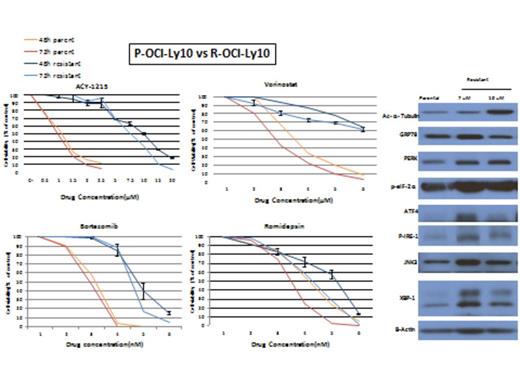Abstract
Histone deacetylase (HDAC) inhibitors possess marked activity in lymphoma and induce pleiotropic effects. HDAC6 is cytoplasmic and binds polyubiquitinated misfolded proteins to facilitate their transport to the aggresome for proteasome-independent degradation. The aggresome is a key outlet for the unfolded protein response (UPR), a quality control mechanism that promotes survival during endoplasmic reticulum stress and signals CHOP (C/EBP-homologous protein) mediated apoptosis when homeostasis cannot be reestablished. To better understand the discrete function of HDAC6 and its role in lymphoma, we developed two lymphoma cell lines to be resistant to the selective HDAC6 inhibitor ricolinostat (Acetylon Pharmaceuticals, Inc). Ricolinostat has demonstrated activity in preclinical models of multiple myeloma and lymphoma and is currently being studied in the clinical setting for both of these entities (clinicaltrials.gov identifiers NCT02091063, NCT01323751, NCT01997840 and NCT01583283).
The diffuse large B-cell lymphoma cell line, OCI-Ly10, and the T-cell lymphoma cell line, H9, were cultured in increasing concentrations of ricolinostat over time. Systematic incremental increase in drug concentration exposure led to the development of distinct cell lines with IC50 values 10-20 fold greater than that for parental lines (P). The resistant (R) R-Ly10 achieved an IC50 of 20 µM compared to P-Ly10 of 0.9 µM while the R-H9 achieved an IC50 of 20 µM compared to P-H9 IC50 of 1.2 µM at 48 hrs. Resistance was maintained after repeated passages for >1 month. Resistance was not conferred by up-regulation of efflux pumps as determined by co-exposure with verapamil which did not increase the sensitivity to ricolinostat. Interestingly the R-Ly10 was also resistant to vorinostat which strongly inhibits HDAC6 (R-Ly10 IC50 7 µM vs P-Ly10 IC50 2 µM), and sensitive to romidepsin which is known to predominantly inhibit HDAC1, 2, and 3 with minimal activity against HDAC6 (R-Ly10 IC50 5.2 nM vs P-Ly10 IC50 4.5 nM). In addition, treatment of R-Ly10 with bortezomib demonstrated intermediate activity underscoring the concept that although the drug targets are vastly different, both drugs mechanism converge on the processing of misfolded proteins (R-Ly10 IC50 4.5 nM vs P-Ly10 IC50 3.3 nM).
Compared to parental cells, resistant cells did not depolarize the mitochondrial membrane following treatment with ricolinostat 2.5 µM. However, there was no difference in the BH3 profiles of the R- and P-cell lines. R-Ly10 displayed increased protein expression of tubulin and down-regulation of HDAC6 as detected by immunoblotting. The resistant cells also displayed down-regulation of GRP78, the master regulator of the UPR, with concomitant up-regulation of both the PERK and IRE-1 pathways leading to up-regulation of p-eIF2α, ATF4, JNK3 and XBP-1. Additionally, p-AKT and total AKT were more highly expressed in the resistant line compared to the parental.
Gene expression profiling was performed on R-Ly10 and compared to P-Ly10 and results were analyzed by GSEA and gene cluster analysis. There were 931 genes significantly up-regulated and 391 genes significantly down-regulated (p<0.05). Genes of interest in the resistant line include up-regulation of JNK3, IKZF2, HDAC9 and FYN, as well as down-regulation of SH3BP5 and LCK. The change in expression was confirmed by immunoblot analysis. Given the up-regulation of FYN, a tyrosine kinase in the B-cell receptor pathway, and down-regulation of SH3BP5 a negative regulator of the Bruton's tyrosine kinase, R-OCI-Ly10 cells were treated with ibrutinib and compared to the parental line. Treatment with ibrutinib 0.1 µM was able to overcome resistance resulting in 70% viability in R-Ly10 compared to 64% in P-Ly10 at 72 hr. P-Ly10 cells treated with ibrutinib in combination with ricolinostat demonstrated synergy with RRR=0.46 (where RRR<1 connotes synergy) after 96 hr exposure to ibrutinib and 48 hr exposure to ricolinostat.
The development of these ricolinostat resistant cell lines has proven to be a powerful tool to better understand the mechanistic role of HDAC6 in lymphoma and may potentially lead to the identification of biomarkers of response or resistance. It has also been useful in guiding rational drug partners that target complimentary pathways. Further characterization of the cell lines is underway.
Amengual:Acetylon Pharmaceuticals, INC: Research Funding. Off Label Use: ACY-1215 is not approved for the treatment of lymphoma..
Author notes
Asterisk with author names denotes non-ASH members.


This feature is available to Subscribers Only
Sign In or Create an Account Close Modal